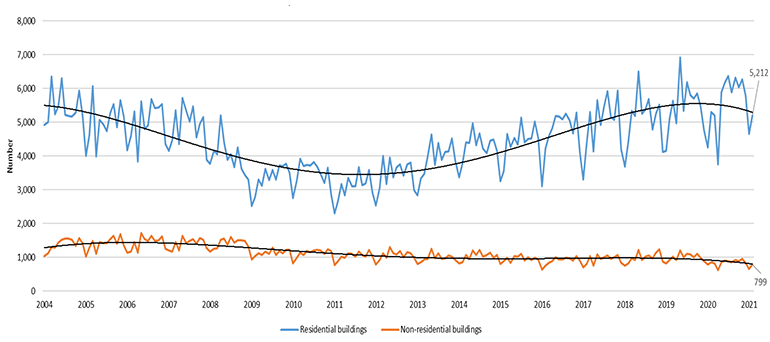Construction sector trends monthly media and information overview: April 2021
An overview of the key research, data, and media releases in April 2021.
On this page
The key themes were:
- Supply chain issues and rising construction costs were trending themes in the past month.
- Leaky apartments and the quality of building stock were highlighted in the media.
- The gap in building demand and supply and housing affordability continued to be strong themes.
General summary
Media articles focused on supply chain concerns continued to trend through April 2021. Sub-themes within this content included rising freight costs, concerns around the availability of timber products, proposed tariffs on exported timber products, and the trickle-down effect of increasing overall construction costs.
Supply-chain issues were likewise highlighted in research and data releases, and were linked to rising construction costs, shortage of skilled labour, and higher costs of labour.
A new report from Stats NZ and the Ministry for the Environment (MfE), delved into land usage within New Zealand, and reported that urban areas had expanded significantly from the late 1990s.
There were fewer construction-related research and statistics released in April compared to previous months in 2021.
Research releases
NZIER’s Quarterly Survey of Business Opinion (QSBO) identified a modest improvement in overall business confidence in the March Quarter of 2021. However, the building sector was viewed as being more pessimistic, with the survey claiming supply chain disruptions, along with a shortage of skilled labour, affecting current levels of building activity. However, the QSBO also recognised that there was a solid pipeline of construction going forward.
Westpac Bank’s housing and economic forecast update published in early April, delved into the Government’s housing policy announcement from March, and it’s potential effect on the housing market. In terms of future residential building, the update concluded that high levels of home building were still expected over the coming years, particularly with a large number of projects already in the pipeline.
Economic Bulletin 9 April 2021(external link) — Westpac
Data releases
Stats NZ and the Ministry for the Environment (MfE) produced the report, Our land 2021, presenting data on New Zealand’s land cover and associated land-use and changes. A key figure from the report was that New Zealand’s total urban area expanded by 14.6% (30, 264 hectares) between 1996 and 2018, with 87%of the population living in towns and cities. Additionally, highly productive land became more fragmented between 2002 and 2019, especially through residential development of land sized 2–8 hectares (where lifestyle blocks were about 5 hectares on average).
Our land 2021(external link) — Stats NZ
Stats NZ also highlighted that the cost of building a new house rose 1.2% in the March 2021 quarter. The “reported shortages of many building products such as timber and house fittings and furnishings, as well as higher labour costs” were attributed to the rise in construction costs.
Prices for housing a transport rise in March 2021 quarter(external link) — Stats NZ
Media
There were over 730 building and construction-related media articles generated in April, a slight decrease from the over 760 articles produced throughout March 2021.
Trending media content included key themes of: escalating supply chain concerns; rising construction costs (also in relation to supply chain issues); leaky apartments and the quality of the building stock; and the gap between housing supply and demand, and the effect on overall housing affordability.
Both domestic and international supply chain issues were a focus across broadcast, press and internet mediums. Recurring points of discussion were on rising costs of freight, stockpiling of timber products, and the trickle-down impact of supply chain issues on construction costs. TVNZ reported that the shortage could lead to another leaky homes crisis, with claims that shortages of building materials could lead to inadequate substitutions being used. The Building Industry Federation’s Julian Leys confirmed that some businesses in the sector were stockpiling supplies, including timber, and that increasing tariffs may have a dampening effect on some woods going overseas. Mike Craig, Chair of Certified Builders Association provided similar comments in a Radio New Zealand Interview, stating that a viable option to positively impact timber supplies was for Government to introduce tariffs on logs sent to be processed overseas.
Building materials scarce while logs sit in forest(external link) — NZ Herald
Wood supply uncertainty: Tariffs on export logs suggested(external link) — RNZ
A Prime TV documentary garnered strong media interest, as it revisited the leaky home issue with respect to multi-unit buildings. “A Living Hell: Apartment Disasters” outlined multiple issues with some of New Zealand’s apartment buildings. For example, a building that was leaking would not just have water-tightness issues, it was also unlikely to be fire compliant, and was likely to have structural issues. Those behind the documentary called for MBIE to work together with BRANZ, NZ Standards, housing and construction groups, and real estate professionals to address these issues.
Living Hell: Apartment Disasters' exposes Stonefields block(external link) — Stuff
The gap between strong demand for housing and the available supply continued to trend across media outlets in April. Stuff.co.nz reported the Ministry of Housing and Urban Development advising the Housing Minister that increasing the overall supply of new build housing in the right places will have the greatest impact on affordability.
Increasing housing supply the key to affordability, minister advised(external link) — Stuff
Total number of monthly residential and non-residential buildings (January 2004 to February 2021)

Image description

